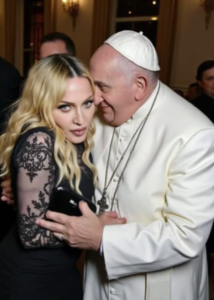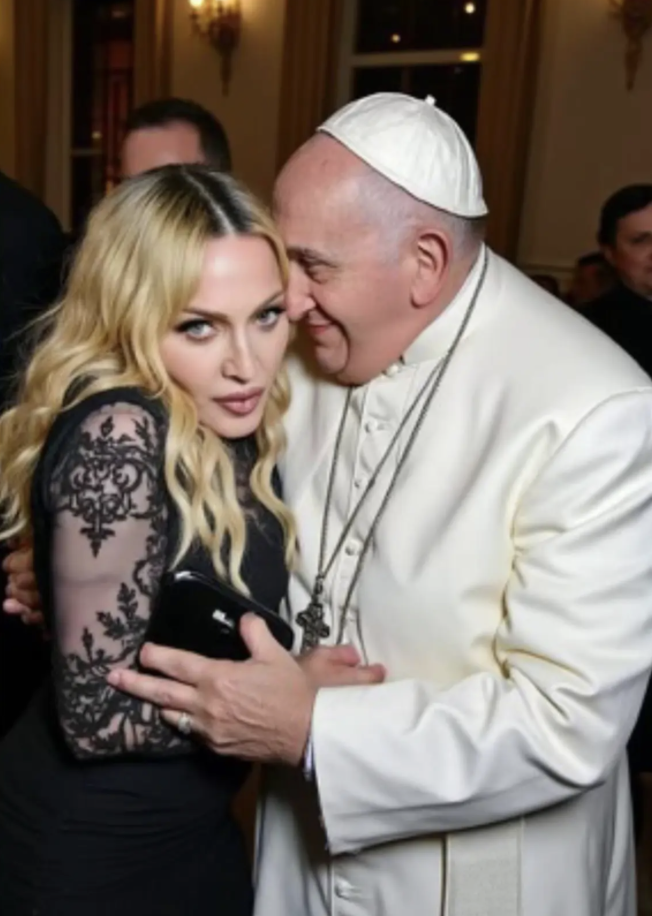She made an entire career out of it, being out there, flashy and controversial, but really, do you still need to do that?
But I guess she needs to stay relevant. The music is not cutting it, so she does it like that.
AI-generated images spark controversy with intimate depictions of Pope Francis
Artificial intelligence (AI) has revolutionized various industries, including art. AI-generated art has gained significant attention in recent years, with its ability to create stunning and thought-provoking pieces. However, this technological advancement has also raised ethical concerns, particularly when it comes to portraying religious figures. One such controversy emerged when AI-generated images depicting Pope Francis in intimate moments surfaced, igniting a heated debate about the boundaries of art, privacy, and religious sensitivities.
The rise of AI-generated art and its impact on religious figures
AI-generated art has become increasingly popular due to its ability to create unique and captivating pieces. Artists and programmers have developed algorithms that can analyze vast amounts of data and generate images, paintings, and even music. This technology has allowed for the creation of art that challenges traditional notions and pushes boundaries.
Religious figures, including Pope Francis, have long been subjects of artistic expression. Paintings, sculptures, and photographs have depicted religious leaders throughout history. However, AI-generated art presents a new dimension to this portrayal, as it blurs the line between reality and imagination. The ability of AI to create realistic images of religious figures, including intimate moments, has sparked controversy and raised questions about the appropriateness of such depictions.

Exploring the ethical implications of AI-generated images portraying religious leaders
The emergence of AI-generated images portraying religious leaders, such as Pope Francis, raises several ethical concerns. One of the primary concerns is the violation of privacy. Religious figures, like any other individuals, have a right to privacy, and the creation of intimate AI-generated images infringes upon this right. These images can be seen as invasive and disrespectful, as they depict moments that were never intended to be shared with the public.
Furthermore, the creation of AI-generated images of religious leaders can be seen as a form of exploitation. These images can be manipulated and used for various purposes, including political agendas or personal gain. The lack of consent from the religious figures themselves adds to the ethical dilemma surrounding these AI creations.
Public outrage and debate surrounding the AI-generated images of Pope Francis
The release of AI-generated images depicting Pope Francis in intimate moments sparked public outrage and ignited a passionate debate. Many individuals expressed their anger and disappointment, arguing that these images crossed a line and disrespected the Pope and the Catholic Church. Social media platforms were flooded with discussions, with some defending the artistic freedom of AI-generated art, while others condemned it as a violation of religious sensitivities.
The controversy surrounding these images highlights the deep emotional connection people have with religious figures and the importance of respecting their beliefs and values. It also raises questions about the responsibility of artists and programmers in creating AI-generated art that respects the boundaries of privacy and religious sensitivities.
Church response: Vatican’s stance on AI-generated images and privacy concerns
The Catholic Church, represented by the Vatican, responded to the controversy surrounding the AI-generated images of Pope Francis. The Vatican expressed its concern over the violation of privacy and the potential harm caused by these images. It emphasized the need for ethical guidelines and regulations to protect the privacy and dignity of religious figures.
The Vatican’s response reflects the Church’s commitment to upholding the values and teachings it represents. It acknowledges the importance of respecting the privacy of religious leaders and the potential harm that can arise from the misuse of AI-generated images. The Church’s stance on this issue adds weight to the ongoing debate and calls for a more thoughtful approach to AI-generated art.
The future of AI-generated art and its potential impact on religious sensitivities
As AI technology continues to advance, the future of AI-generated art remains uncertain. While it offers exciting possibilities for artistic expression, it also presents challenges that need to be addressed. The controversy surrounding the AI-generated images of Pope Francis serves as a wake-up call for artists, programmers, and society as a whole to consider the ethical implications of this technology.
Moving forward, it is crucial to establish ethical guidelines and regulations that protect the privacy and dignity of religious figures. Artists and programmers should be encouraged to explore the boundaries of art while respecting the sensitivities and beliefs of individuals and communities. Open dialogue and collaboration between artists, religious leaders, and the public can help shape a future where AI-generated art can coexist with religious sensitivities.
In conclusion, the controversy surrounding AI-generated images depicting Pope Francis in intimate moments highlights the ethical concerns and challenges posed by this technology. The rise of AI-generated art has opened up new possibilities for artistic expression, but it also raises questions about privacy, exploitation, and religious sensitivities. The response from the Vatican emphasizes the need for ethical guidelines and regulations to protect the privacy and dignity of religious figures. Moving forward, it is essential to foster open dialogue and collaboration to ensure that AI-generated art respects the boundaries of privacy and religious sensitivities.





